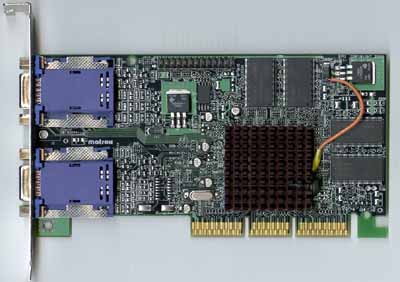The G450 takes advantage of the fact that, in spite of the high prices and poor availability of the MAX initially, the G400 was a very good product. Its DualHead feature gained so much support, especially from the professional markets that it quickly became Matrox’s claim to fame, pushing their “king of 2D” title into the passenger’s seat.
Unfortunately, even a year after the release of the G400, the chip is still entirely too expensive to be a viable option for many users. With the cheapest DualHead G400 card still selling for $180, it’s very difficult to resist the temptations of a GeForce2 MX which offers much higher 3D performance at a considerably lower price; and for around the same price a GeForce2 MX based card with TwinView isn't far from reach.
Instead of allowing NVIDIA to completely take over the market they helped to create with their first DualHead products, Matrox designed the G450 to be a G400 chip targeted mainly at the corporate market. Instead of even bothering to compete in the gaming market with their 1 year old 3D core, Matrox will save that for a later chip, for now, the G450 is a return to their roots in corporate/professional systems.
The G450 chip is a highly integrated yet low-cost version of the G400. The first change is a die shrink from the 0.25-micron process of the original G400 to a much smaller and cooler running 0.18-micron G450 chip. This paves the way for the rest of the improvements Matrox made on the original G400 design.
Continuing this trend of downsizing, Matrox took away the G400’s 128-bit memory bus and replaced it with a 64-bit bus. Moving down to a 64-bit memory bus cuts the G450’s pin count considerably, but at the same time cuts the G450’s memory bandwidth in half. In order to help lessen the blow of this change, Matrox added support for DDR SDRAM. In theory, DDR SDRAM, on a 64-bit memory bus, should perform identically to the SDR memory that was on the original G400 boards with their 128-bit memory bus.
While Matrox continues their tradition of not talking about operating frequencies of their products, the DDR SDRAM on the G450 appears to be running at 166MHz, which is the same frequency that the original G400’s SDR memory operated at. However, since the memory is in fact DDR SDRAM it is operating at an effective 333MHz, meaning that the G450 should theoretically have the same amount of memory bandwidth as the regular G400 (approximately 2.7GB/s). This will inherently limit its performance to below that of the G400MAX which has a 200MHz memory clock.
The core itself appears to be running at the same clock speed as the original G400, 125MHz. This gives it a theoretical fill rate of 250MTexels/s, identical to that of the original G400 and still under the 333MTexels/s fill rate of the G400MAX.
So far it seems as if Matrox has not used the 0.18-micron process of the G450 to their advantage at all, since the G450 holds seemingly identical specifications to its predecessors. What did Matrox use the 0.18-micron process for?












1 Comments
View All Comments
bstct - Tuesday, October 31, 2006 - link
Thanks for the excellent and helpful article.